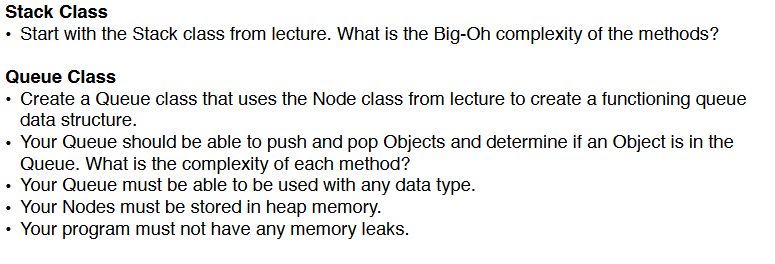Answered step by step
Verified Expert Solution
Question
1 Approved Answer
The stack and node classes are below. Stack.h: #ifndef NODEB_STACK_H #define NODEB_STACK_H #include Node.h #include using namespace std; template typename Object> class Stack { private

The stack and node classes are below.
Stack.h:
#ifndef NODEB_STACK_H #define NODEB_STACK_H #include "Node.h" #includeusing namespace std; templatetypename Object> class Stack { private: Node
Node.h:
templatetypename Object> class Node { private: Object item; Node* next; public: Node(Object newItem) { item = newItem; next = nullptr; } Node(Object newItem, Node* nextNode) { item = newItem; next = nextNode; } void setItem(Object newItem) { item = newItem; } Object getItem() const { return item; } void setNext(Node* nextNode) { next = nextNode; } Node* getNext() const { return next; } }; Stack Class Start with the Stack class from lecture. What is the Big-Oh complexity of the methods? Queue Class Create a Queue class that uses the Node class from lecture to create a functioning queue data structure. . Your Queue should be able to push and pop Objects and determine if an Object is in the Queue. What is the complexity of each method? . Your Queue must be able to be used with any data type. Your Nodes must be stored in heap memory. . Your program must not have any memory leaks. Stack Class Start with the Stack class from lecture. What is the Big-Oh complexity of the methods? Queue Class Create a Queue class that uses the Node class from lecture to create a functioning queue data structure. . Your Queue should be able to push and pop Objects and determine if an Object is in the Queue. What is the complexity of each method? . Your Queue must be able to be used with any data type. Your Nodes must be stored in heap memory. . Your program must not have any memory leaks Step by Step Solution
There are 3 Steps involved in it
Step: 1

Get Instant Access to Expert-Tailored Solutions
See step-by-step solutions with expert insights and AI powered tools for academic success
Step: 2

Step: 3

Ace Your Homework with AI
Get the answers you need in no time with our AI-driven, step-by-step assistance
Get Started


